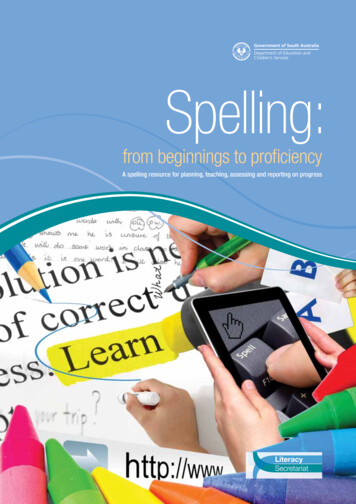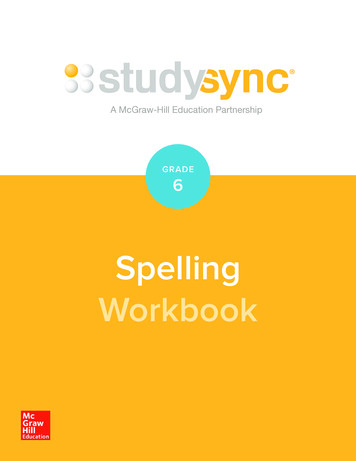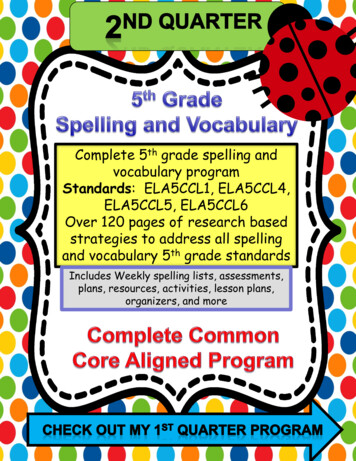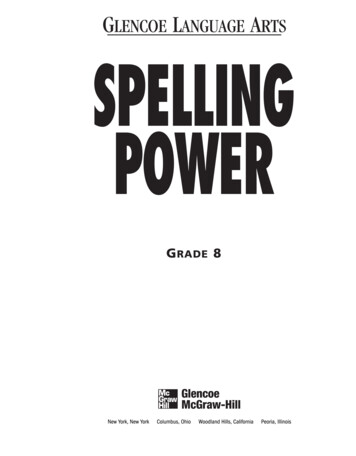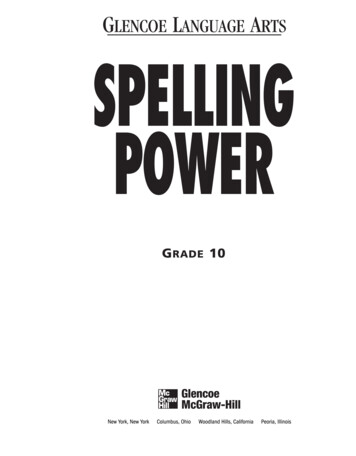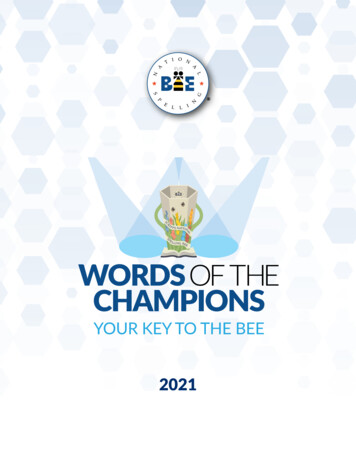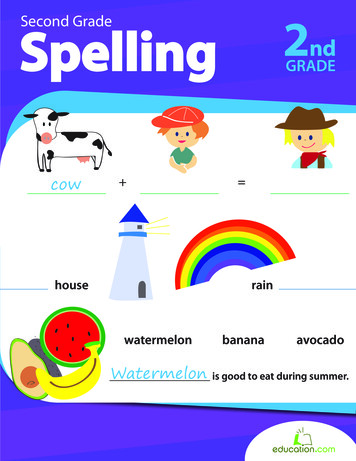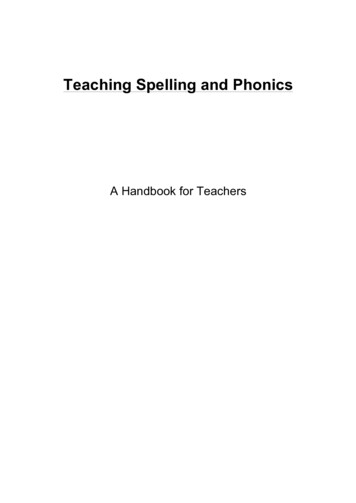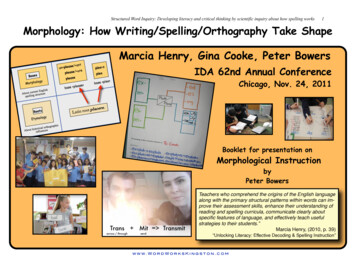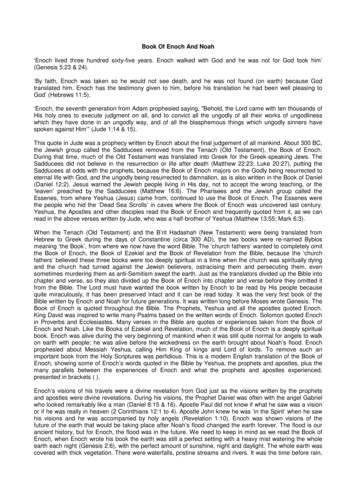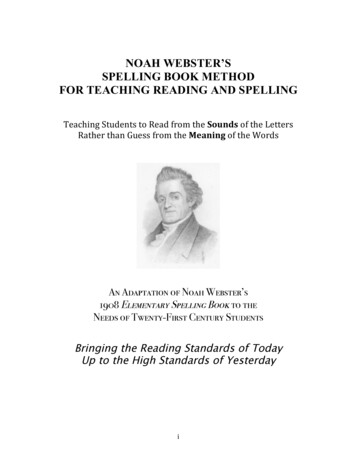
Transcription
NOAH WEBSTER’SSPELLING BOOK METHODFOR TEACHING READING AND SPELLINGTeaching Students to Read from the Sounds of the LettersRather than Guess from the Meaning of the WordsAn Adaptation of Noah Webster’s1908 Elementary Spelling Book to theNeeds of Twenty-First Century StudentsBringing the Reading Standards of TodayUp to the High Standards of Yesterdayi
NOAH WEBSTER’S SPELLING BOOK METHODFOR TEACHING READING AND SPELLINGCopyright 2014 Donald L. PotterAll rights reservedISBN-10: 1496153278ISBN-13: 978-1496153272www.donpotter.netii
Dedicated to Miss Geraldine E. Rodgers, B.A., M. S.Retired Primary Grades Teacher withTwenty-Three Years of ExperienceAuthor ofThe Hidden Story: How America’s Present-Day Reading Disabilities Grew Out of theUnderhanded Meddling of America’s First Experimental Psychologist, Young WilliamJames. ((1996, 1997, 1998)Why Jacques, Johann and Jan CAN Read. 1977-1978 Research in oral reading accuracy. (2005) The rediscovery of “objective readers” and “subjective readers.”The History of Beginning Reading: From Teaching by “Sound” to Teaching by“Meaning.” (1995, 2001) This is Mrs. Rodgers’ three-volume magnum opus of libraryresearch into the history of instruction in beginning reading America. No college libraryshould be without this in-depth study.The Case for the Prosecution: In the Trial of Silent Reading “Comprehension” Tests,Charged with the Destruction of American Schools. (2007) This is a book of essays from1981 to 1983.“Why Noah Webster’s Way Was the Right Way.” (June 10, 2004) It was this essaythat motivated me to start teaching Webster’s spelling book method of teaching readingand spelling. The happy results further motivated me to retype Webster’s method and republish it in the present format, which I use with my tutoring students of all ages.“Historical Introduction to Leonard P. Ayres’ A Measuring Scale of Ability in Reading.” (1984) Explaining the cumulative high frequency word effect.Born-Yesterday World of Reading “Experts” - A Critique on Recent Research onReading and the Brain. (2003) This paper was prompted by a request from Dr. PatrickGroff.iii
iv
PREFACEExcerpts from the 1866 Edition with CommentsIn Syllabication it has been thought best not to give the etymological division of theQuarto Dictionary, but to retain the old mode of Dr. Webster as best calculated to teachyoung scholars the true pronunciation of words. [My experience proves that this is thebest way to divide the words for purposes of teaching reading and spelling. This is basically the respelling division in the modern dictionaries.]The plan of classification here executed is extended so as to comprehend every important variety of English words, and the classes are so arranged, with suitable directionsfor the pronunciation, that any pupil, who has mastered the Elementary Tables, will findlittle difficulty in learning to form and pronounce any word properly belonging to ourvernacular language. [Webster’s Speller is a “System” of English orthography in the truesense. It will enable students to develop the skills necessary to be proficient in Englishreading and spelling. It can be used on all levels: beginning, intermediate, and advanced.]The Tables intended for Exercises in Spelling and forming words, contain the originalwords, with the terminations only of their derivatives. The tables answer the importantpurpose of teaching the manner of forming the various derivatives, and the distinctions ofthe parts of speech, and thus anticipate in some degree, the knowledge of grammar; at thesame time they bring into small compass a much greater number of words than could beotherwise comprised in so small a book. [The Spelling book concentrates an enormousamount of practice in reading and spelling into an exceptionally small space, allowingstudents to attain high levels of reading ability in an amazingly short period of time.]The reading lessons are adapted, as far as possible, to the capacities of children, and totheir gradual progress in knowledge. These lessons will serve to substitute variety for thedull monotony of spelling, show the practical use of words in significant sentences, andthus enable the learner to better understand them. The consideration of diversifying thestudies of the pupil has also had its influence on the arrangement of the lessons forspelling. It is useful to teach the signification of words, as soon as they can comprehendthem; but the understanding can hardly keep pace with the memory, and the minds ofchildren may well be employed in learning to spell and pronounce words whose signification is not within their capacities; for what they do not clearly comprehend at first theywill understand as their capacities are enlarged.The objects of a work of this kind being chiefly to teach orthography and pronunciation, is judged most proper to adapt the various Tables to these specific objects, and omitextraneous matter. In short, this little book is so constructed as to condense into thesmallest compass a complete SYSTEM of ELEMENTS for teaching the language; andhowever small such a book may appear, it may be considered as the most important classbook, not of religious character, which the youth of our country are destined to use. [Iknow of no other book that concentrates so much language power into such a smallspace.]New York, 1866. William G. Webster. (Comments: Odessa, TX, 2009. Donald L. Potter)v
PREFACE TO THE 1908 EDITIONThe modifications in this revision are not of a character to embarrass those teacherswho used the previous editions in the same class. The principal changes are:In many instances an improved form of type;The substitution of living words in the place of those words that have become obsolete.The omission of orthoëpical marks where they are clearly unnecessary, as explainedbelow;The correction of a few errors in pronunciation, etc. etc.;The addition at the end of the book, of four new pages of common words difficult tospell.The repetition of orthoëpical mark has been omitted as needless in a succession of twoor more words having the same vowel letter and sound. In such cases only the first wordis marked – the syllable of this leading word being the key to the corresponding unmarked syllables in the words, which follow. But whenever there is liability to mispronounce, the right way is indicated by marking the doubtful syllable.PREFACE TO THE 2011 EDITIONThe Tables have been converted from columns of words into rows in this edition to encourage good left to right word scanning. This allowed me to increase the type size forease of reading while reducing the number pages.Bold has been substituted for Webster’s accent marks. Students find this an acceptablemethod for indicating stress. A key element in the book’s uncommon success is the classification of polysyllables according to accent. No modern work that I am aware ofmakes use of this important feature. In the 1822 edition of his American Spelling Book,Webster informs us, “In nine-tenths of the words in our language, a correct pronunciationis better taught by a natural division of the syllables and a direction for placing the accent, than by a minute and endless repetition of characters.”A few words have been modernized in their pronunciation.The Syllabary has been slightly expanded to make it more complete, and the SyllabaryTables are organized in a more logical manner.Helpful resources for teaching Webster’s method are available on the Internet atwww.donpotter.net.Students who complete Webster’s American Spelling Book Method of Teaching Reading and Spelling will gain a command English reading, vocabulary, and spelling that isavailable in no other single book.I consider it a privilege of a lifetime to make this edition available to educators whoseminds are open to going to the past to improve the future.Donald L. Potter, Odessa, Texas, 2009, 2011, 2013, 2014, 2016.vi
ANALYSIS OF SOUNDSIN THE ENGLISH LANGUAGEThe Elementary Sounds of the English language are divided into twoclasses, vowels and consonants.A vowel is a clear sound made through an open position of the mouthchannel, which molds or shapes the voice without obstructing its utterance;as a (in far, or fate, etc.), e, o.A consonant is a sound formed by a closer position of the articulating organs than any position by which a vowel is formed, as b, d, t, g, sh. In forming a consonant the voice is compressed or stopped.A diphthong is the union of two simple vowel sounds, as ou (äo͝o) in out,oi (a̤ĭ) in noise.The English Alphabet consists of twenty-six letters, or single characters,which represent vowel, consonant, and diphthongal sounds – a, b, c, d, e, f,g, h, i, j, k, l, m, n, o, p, q, r, s, t, u, v, w, x, y, z. The combinations ch, sh, th,and ng are also used to represent elementary sounds; and another sound isexpressed by s, or z; as in measure, azure, pronounced mĕzh-yoor, ăzh-ur.Of the foregoing letters, a, e, o, are always simple vowels; i and u arevowels (as in in, us), or diphthongs (as in time, tune); and y is either a vowel(as in any), a diphthong (as in my), or a consonant (as in ye).Each of the vowels has its regular long and short sounds which are mostoften used; and also certain occasional sounds, as that of a in last, far, care,fall, what; e in term, there, prey, i in firm, marine; o in dove, for, wolf,prove; and u in furl, rude, and pull. These will now be considered separately.A. The regular long sound of a is denoted by a horizontal mark over it; asin ān-cient, pro-fāne; and the regular short sound by a curve over it; as, căt,păr-ry.Occasional sounds. –The Italian sound is indicated by two dots over it; asbär, fä-ther; –the short sound of the Italian a, by a single dot over it; as, fȧst,lȧst (Modern English, as făst, lăst); –the broad sound, by two dots below it;as, ba̤ll, sta̤ll; – the short sound of broad a, by a single dot under it; as, whạt,quạd-rant; – the sound of a before r in certain words like care, fair, etc., isrepresented by a sharp or pointed circumflex over the a, as, câre, hâir, fâir,etc.1
E. The regular long sound of e is indicated by a horizontal mark over it;as, mēte, se-rēne; the regular short sound, by a curve over it; as, mĕt, re-bĕl.Occasional sounds. –The sound of e like a in care is indicated by apointed circumflex over the e, as in thêir, whêre; and of short e before r incases where it verges toward short u, by a rounded circumflex, or wavy line,over it; as, hẽr, pre-fẽr.I, O, U. The regular long and short sounds of i, o, and u are indicated likethose of a and e by a horizontal mark and by a curve; as, bīnd, bĕnd; dōle,dŏll; tūne, tŭn.Occasional sounds. –When i has the sound of long e it is marked by twodots over it; as, fa-tïgue, ma-rïne; –when o has the sound of short u, it ismarked by a single dot over it; as, dȯve, sȯn; –when it has the sound of o͞o,it is marked with two dots under it; as, mo̤ve, pro̤ve. –when it has the soundof o͝o, it is marked with a single dot under it; as, wọlf, wọ-man; –when it hasthe sound of broad a, this is indicated by a pointed circumflex over the vowel; as, nôrth, sôrt; –the two letters oo, with a horizontal mark over them havethe sound heard in the words bo͞om, lo͞om; –with the curve mark, they havea shorter form of the same sound; as, bo͝ok, go͝od; –when u is sounded likeshort oo, it has a single dot under it; as, fụll, pụll; while its lengthenedsound, as when preceded by r, is indicated by two dots; as in rṳde, rṳ-al, rṳby.NOTE. –The long u in unaccented syllables has, to a great extent, thesound of oo, preceded by y, as in educate, pronounced ĕd-yoo-kāte; nature,pronounced nāt-yoor.The long sound of a in late when shortened, coincides nearly with that ofe in let; as adequate, disconsolate, inveterate.The long e, when shortened, coincides nearly with the short i in pit (compare feet and fit). This short sound of i is that of y unaccented, at the end ofwords; as in glory. The short sound of broad a in hall, is that of the short o inholly and of a in what.The short sound of long oo in pool, is that of u in pull, and oo in wool.The short sound of long o in not, is somewhat lengthened before, s, th,and ng; as in cross, broth, belong.The pronunciation of diphthongs oi and oy is the same and uniform; as,in join, joy.The pronunciation of diphthongs ou and ow is the same and uniform; as,in sound, now. But in the terminations ous, ou is not a diphthong, and thepronunciation is us; as, in pious, glorious.2
A combination of two letters used to express a single sound is called adigraph; as, ea in head, or th in bath.The digraphs ai and ay, in words of one syllable, and in accented syllable,have the sound of a long. In unaccented syllables of a few words, the soundof a is nearly or quite lost; as, in certain, curtain. The digraphs au and aw,have the sound of broad a (a as in fall); ew, that of u long, as in new; and eyin unaccented syllables, that of y or i short, as valley (Modern English longe: ēy).When one vowel of a digraph is marked, the other has no sound; as incōurt, rōad, slōw.The digraphs ea, ee, ei, ie, when not marked, have in his book, the soundof e long; as in near, meet, seize, grieve.The digraph oa, when unmarked, has the sound of o long.Vowels, in words of one syllable, following by a single consonant and efinal, are long; as, in fate, mete, mite, note, mute, unless marked, as in dȯve,gĭve.The articulation or sounds represented by the consonants are best apprehended by placing a vowel before them in pronunciation, and prolongingthe second of the two elements; thus, eb, ed, ef, eg, ek, el, em, en, ep, er, es,et, ev, ez.Those articulations, which wholly stop the passage of the breath from themouth, are called, close, or mute, as b, d, g, k, p, t.Those articulations which are formed either wholly or in part by the lips,are called labials; as, b, f, m, p, v.Those articulations which are formed by the tip of the tongue and theteeth, or the gum covering the roots of the teeth, are called dentals; as, d, t,th, (as in thin, this).Those which are formed by the flat surface of the tongue and the palate,are called palatals; as, g, k, ng, sh, j, y.The letters s and z are also called sibilants, or hissing letters.W (as in we) and y (as in ye) are sometimes called semi-vowels, as beingintermediate between vowels and consonants, or partaking of the nature ofboth.B and p represent one and the same position of the articulating organs;but p differs from b in being an utterance of the breath instead of the voice.D and t stand for one and the same articulation, which is a pressure of thetongue against the gum at the root of the upper front teeth; but t stands for awhispered, and d for a voiced sound.3
F and v stand for one and the same articulation, the lower teeth placed onthe upper lip; but f indicates an expulsion of voiceless breath; v of vocalizedbreath, or tone.Th in thin and th in this represent one and the same articulation, theformer with breath the latter with voice.S and z stand for one and the same articulation, s being a hissing or whispered sound, and z a buzzing and vocal sound.Sh and zh have the same distinction as s and z, whispered and vocal; butzh not occurring in English words, the sound is represented by si or by otherletters; as in, fusion, osier, azure.G and k are cognate letters, also j and ch the first of each couplet beingvocal, the second aspirate or uttered with breath alone.Ng represents a nasal sound.B has one sound only, as in bite. After m, or, before t, it is generally mute;as in dumb, doubt.C has the sound of k before a, o, u, l and r, as in cat, cot, cup, clock, andcrop and of s before e, i, and y, as in cell, cit, cycle. It may be considered asmute before k; and in sick, thick. C, when followed by e or i, before anothervowel, unites with e or i to form the sound of sh. Thus, cetaceous, gracious,conscience, are pronounced ce-ta-shus, gra-shus, con-shense.D has its proper sound, as in day, bid; when preceded in the same syllableby a whispered or non-vocal consonant, it uniformly takes the sound of t, asin hissed (hist).F has only one sound; as in life, fever, except of, in which it has the soundof v.G before a, o, and u, is a close palatal articulation; as, in gave, go, gun;before e, i, and y, it sometimes represents the same articulation, but generally indicates a compound sound like that of j; as in gem, gin, gyves. Before nin the same syllable it is silent; as, in gnaw.H is a mark of mere breathing or aspiration. After r it is silent; as, inrhetoric.I in certain words has the use of y consonant; as, in million, pronouncedmill-yun. Before r it has a sound nearly resembling that of short u, but moreopen; as in bird, flirt.J represents a compound sound, pretty nearly equivalent to that represented by dzh; as, in joy.K has one sound only; as, in king. It is silent before n in the same syllable; as, in knave.L has one sound only; as in lame, mill. It is silent in many words, especially before a final consonant; as, in walk, calm, calf, should.4
M has one sound only; as, in man, flame. It is silent before n in the samesyllable; as, in mnemonics.N has only one sound only; as, in not, sun. It is silent after l and m; as, inkiln, hymn, solemn.P has one sound only; as, in pit, lap. At the beginning of words, it is silent before n, s, and t; as, in pneumatics, psalm, pshaw, ptarmigan.Q has the sound of k, but it is always followed by a u, and these two letters are generally sounded like kw; as, in question.R is sounded as in rip, trip, form, carol, mire.S has its proper sound, as in send, less; or the sound of z, as in rose. Followed by i preceding a vowel, it unites with the vowel in forming the soundof sh; as in mission, pronounced mish-un; –or of its vocal correspondent zh;as in osier pronounced o-zher.T has its proper sound, as in turn, at the beginning of words and at theend of syllables. Before i, followed by another vowel, it unites with i to formthe sound of sh, as, in nation, partial, patience, pronounced na-shun, parshal, pa-shense. But when s or x precedes t, this letter and the i following itpreserve their own sounds; as in bastion, Christian, mixtion, pronouncedbăst-yun, krist-yan, mikst-yun. T is silent in the terminations ten and tle after s; as in fasten, gristle; also in the words often, chestnut, Christmas, etc.V has one sound only; as, in voice, live, and is never silent.W before r in the same syllable is silent, as in wring, wrong. In mostwords beginning with wh the h precedes the w in utterance, that is, wh issimply an aspirated w; thus when is pronounced hwen. But if o follows thiscombination, the w is silent, as in whole, pronounced hole.X represents ks, as in wax; but it is sometimes pronounced like gz; as, inexact. At the beginning of words, it is pronounced like z; as, in Xenophon.Z has its proper sound, which is that of a vocal s; as, in maze.Ch has very nearly the sound of tsh; as, in church: or the sound of k;as, character; or of sh in machine.Gh is mute in every English word, both in the middle and at the end ofwords, except in the following: cough, chough, clough, enough, laugh,rough, slough, tough, trough, in which it has the sound of f; and hiccough, inwhich it has the sound of p. At the beginning of a word, it is pronounced likeg hard; as in ghastly, ghost, gherkin, etc.; hence this combination may besaid not to have a proper or regular sound in any English word.Ph has the sound of f, as in philosophy; except in Stephen, pronouncedSte-vn.Sh has one sound only; as in shall.5
Th has two sounds; whispered, as in think, both; and vocal, as in thou,this. When vocal, the th is marked thus, (ŧh), as in thou.C has the sound of sk before a, o, u, and r; as in scale, scoff, sculpture,scroll; and the sound of s alone before e, i, and y; as, scene, scepter, science,Scythian.ACCENT.Accent is the forcible stress or effort of voice on a syllable, distinguishing it from others sin the same word, by a greater distinctness of sound.The accented syllable is designated by bold font.The general principal by which accent is regulated, is, that the stress ofvoice falls on that syllable of a word, which renders the articulations mosteasy to the speaker, and most agreeable to the hearer. But this rule has theaccent of most words been imperceptibly established by a long and universalconsent.When a word consists of three or more syllables, ease of speaking requires usually a secondary accent, of less forcible utterance than the primary; but clearly distinguishable from the pronunciation of unaccented syllables; as in su-per-flu-it-y, lit-er-ar-y. The strongest accent is on the un-derlined font.6
KEY TO THE PRONUNCIATIONVOWELSREGULAR LONG AND SHORT SOUNDSLONG. –ā, as in fame; ē, as in mete (and y as in lady); ī as in fine; ō, as innote; ū as in mute; ȳ, as in fly.SHORT. –ă, as in fat; ĕ, as in met; ĭ, as in fin; ŏ as in not ŭ, as in but; y̆, as innymph.VOWELS. –OCCASIONAL SOUNDSEXAMPLES.â, as in care,ä Italian, as inȧ, as in last (ă in Modern American English)a̤ broad, as in allạ, as in what (like short o)ê like â, as inẽ, as in term,e̱ , like long a, as inï, like long e as inĩ, as in bird,ȯ like short u, as ino̤ like long oo, as inọ like short oo, as inô like broad a, as ino͞o (long oo), as ino͝o (short oo), as inṳ long, preceeded by r, as inụ like o͝o, as ine, i, o (italic) are silentâir, shâre, pâir, beâr.fäther, fär, bälm, päth.ȧsk, grȧss, dȧnce, brȧnch.ca̤ll, ta̤lk, ha̤ul, swa̤rm.wạn, wạnton, wạllowthêre, hêir, whêre, êre.ẽrmine, vẽrge, prefẽr.pre̱ y, the̱ y, e̱ ight.pïque, machïne, mïem.fĩrm, vĩrgin, dĩrt.dȯve, sȯn, dȯne, wȯn.pro̤ve, do̤, mo̤ve, to̤mb.bọsom, wọlf, wọman.ôrder, fôrm, stôrk.mo͞on, fo͞od, bo͞oty.fo͝ot, bo͝ok, wo͝ol, go͝od.rṳde, rṳmor, rṳral.pụt, pụsh, pụll, fụll.token, cousin, mason.REGULAR DIPHTHONGAL SOUNDSEXAMPLESoi, or oy (unmarked), as inou, or ow (unmarked), as inoil, join, toyout, owl, vowel7
CONSONANTSç, soft, like s sharp, as inc, hard like k, as inch (unmarked), as inçh soft, like sh as inch hard, like k, as inḡ hard, as inġ soft, like j, as ins sharp (unmarked), as ins soft or vocal, as inth sharp (unmarked) as inŧh flat, or vocal, as inng (unmarked), as inn (much like ng), as inx, like gz, as inçede, merçycall, concur.child, choose, much.maçhine, çhaise.chorus, epoch.ḡet, beḡin, fogḡy.ġentle, ġinġer, eleġy.same, gas, dense.has, amuse, prison.thing, path, truth.ŧhine, ŧheir, wiŧher.sing, single.linger, link, uncle.exist, auxiliary.ph (unmarked), like f: as in sylph. qu (unmarked), like kw, as in queen.wh (unmarked), like hw as in what, when, awhile.This “Key to Pronunciation” is from Noah Webster’s Elementary Spelling Book (1908).This form of diacritical marks was first introduced in the 1829 edition. It is quite similarto the 1908. Interestingly, no major changes were introduced during those dates. Before1829, Webster used “figures” or numbers over the vowels to indicate sounds.An audio for the “Analysis of English Sounds” and the “Key” is available for free on the“Spelling Book Reference Page” of the www.donpotter.net web site.8
THE ALPHABET.Roman ghijklmnopqrstuvwxyz&*Names of ouble uekswizeandDOUBLE LETTERSff, ffl, fi, fl, ffi, æ, œ.*This is not a letter, but a character standing for and.9
Script (Cursive) Alphabet.A B C D E F G HI J K L M N OP Q R S T U VW X Y Za b c d e f g hi j k l m n op q r s t u vw x y z1 2 3 4 5 6 7 8 9 010
The SyllabaryNo. ogobūcudufugubȳçydyfygyġyMost syllables ending in a vowel (open syllables) are long. They say theirletter name. ce, ci and cy are pronounced se, si, sy.No. sytyvywyNo. owo11
No. udufugSyllables ending in a consonant (closed syllables) are short (i.e., cab, Jeb, fib, bob, cub)No. nopŭjukulumunupôrŏsotovoxozûrŭsutuvuxuzNo. 6ärăsatavaxazẽrĕsetevexezîrĭsitivixizThe closed syllables with r are prounounced like: car, her, first, corn and nurse.12
No. ȳŧhychyshyphyNo. oNo. hithōŧhochoshopho13
No. ūsplȳsprystryshryscrysclysce, sci, scy are pronounced se, si, sy.No. lo14
No. 12. – 53 Wordscăb, dab, nab, tab, nĕb, web, bĭb, fib, jib, nib, rib, bŏb, cob,fob, hob, job, lob, mob, rob, sob, dŭb, sub, hub, rub, tub,lăp, sap, rĭp, nip, sŏp, băd, gad, had, lad, mad, pad, sad, lĕd,red, wed, hĭd, did, lid, rid, kid, mid, ḡŏd, hod, sod, nod,odd, pod, rod.No. 13. – 38 Wordslŏg, dog, bog, bŭd, mud, băg, cag, sag, fag, hag, jag, lag,nag, tag, rag, wag, lĕg, keg, pĭg, fig, rig, wig, bŭg, dug,hug, jug, tug, mug, pug, rug, dăm, ham, jam, kam, lam,ram, tam, yam.No. 14. – 41 Wordshĕm, ġem, dĭm, him, rim, dŭm, ḡum, hum, mum, rum, sum,băn, dan, fan, man, pan, ran, tan, rĕn, pen, ten, wen, bĭn,fin, hin, kin, pin, sin, tin, win, cŏn, don, bŭn, dun, fun, gun,pun, run, sun, tun, nun.No. 15. – 47 Wordshăp, rap, map, lap, pap, tap, gap, dĭp, hip, rip, tip, lip, pip,sip, kip, nip, fŏp, hop, top, pop, sop, lop, bär, far, tar, jar,mar, par, băt, fat, rat, hat, mat, sat, pat, vat, bĕt, jet, ḡet, let,met, net, wet, pet, set, yet, hăs.No. 16. – 48 Wordspĭt, çit, fit, lit, mit, nit, pit, sit, wit, bŏt, cot, dot, jot, lot, not,pot, rot, sot, got, wot, bŭt, cut, hut, jut, nut, rut, lăx, tax,wax, sĕx, vex, fĭx, mix, pix, six, bŏx, fox, wạd, wạn, wa̤r,wạs, wạt, căn, cap, cat, sap, ġĭn, chit.15
Ann can hem my cap. She has a fan. He hid in his den. Thepig is in his pen. I see ten men. He had a gun. I can see himrun. The map is wet. She will sit by me. He has cut my pen.I had a nut. Can he get my hat? It is in my lap. I will get amap. A bat can fly. A cat can catch a rat. I met the lad. Hesat on my box. The sun is set. I met six men. Ten men satby me. I set the pin on my tin box. Let him get the wax.No. 17. – 56 Wordsbābe, cade, fade, jade, lade, made, wade, bīde, hide, ride,side, tide, wide, ōde, bode, code, mode, lode, node, rode,lobe, robe, cūbe, tube, āçe, dace, face, lace, pace, race,mace, īce, bice, dice, lice, mice, nice, rice, vice, āġe, caġe,gaġe, paġe, raġe, saġe, dōġe, hūġe, bāke, lake, take, make,rake, sake, hake, wake, cake.No. 18. – 47 Wordsdīke, like, pike, tike, cōke, joke, poke, woke, yoke, dūke,Luke, fluke, āle, bale, cale, gale, dale, male, hale, pale, sale,tale, bīle, file, mile, pile, tile, vile, wile, bōle, cole, dole,hole, mole, pole, sole, tole, mūle, rule, cāme, dame, fame,game, lame, name, same, tame.No. 19. – 36 Wordsāpe, cape, tape, nape, rape, pīpe, ripe, wipe, tȳpe, cōpe,pope, lope, mope, hope, rope, mēre, here, sere, ōre, bore,core, fore, gore, lore, more, sore, tore, yore, cove, rove,wove, gāze, haze, maze, raze, craze.16
No. 20. – 53 Wordscūre, lure, pure, dīne, fine, line, mine, kine, nine, pine, sine,wine, vine, bāne, lane, mane, pane, sane, cane, wane, base,āte, date, gate, fate, hate, late, mate, bīte, çite, kite, mite,rite, site, dive, dōse, bone, cone, zone, hone, tone, Jūne,tīne, fāne, vane, vāse, case, rāte, pate, rīve, fūme, tune,sāne.No. 21. – 47 Wordstōrn, worn, sworn, ûrn, burn, churn, spurn, turn, ălps, scalp,hĕlp, kelp, yelp, gŭlp, pulp, dămp, camp, lamp, clamp,ramp, cramp, stamp, vamp, hĕmp, ĭmp, ḡimp, limp, pimp,crimp, shrimp, pŏmp, romp, bŭmp, dump, chump, jump,lump, clump, plump, mump, rump, crump, trump, cärp,scarp, harp, sharp.No. 22. – 42 Wordsasp, gasp, hasp, clasp, rasp, grasp, lĭsp, crisp, wisp, drĕgs,tŏngs, lŭngs, lĕns, gŭlf, chŏps, ăct, fact, pact, tact, tract,sĕct, pĭct, strict, dŭct, ăft, baft, haft, shaft, raft, craft, draft,graft, waft, hĕft, left, weft, gĭft, shift, lift, rift, drift, sift.No. 23. – 48 Wordsŏft, loft, soft, tŭft, bĕlt, felt, melt, smelt, pelt, welt, ḡĭlt, hilt,milt, spilt, tilt, bōlt, colt, dolt, jolt, hold, cănt, scant, plant,rant, ant, chant, grant, slant, pant, bĕnt, dent, lent, pent,çent, spent, rent, sent, tent, vent, went, dĭnt, lint, flint,splint, mint, print, tint, stint.17
No. 24. – 48 Wordsbrŭnt, grunt, runt, wĕpt, swept, ärt, smart, part, tart, snôrt,sort, tort, lăst, blast, mast, zĕst, hest, chest, ăpt, chapt, kĕpt,slept, crept, cärt, dart, hart, chart, mart, start, pẽrt, vert,wert, shôrt, hûrt, shĩrt, flirt, căst, fast, past, vast, dĭdst,midst, bĕst, jest, lest, blest, nest, pest.No. 25. – 30 Wordsrĕst, crest, drest, test, vest, quest, west, zest, fĭst, list, mist,grist, wrist, wist, lŏst, cost, fĩrst, bûrst, curst, durst, thĩrst,bŭst, dust, gust, just, lust, must, rust, crust, trust.Fire will burn wood and coal. Coal and wood will make afire. The world turns round in a day. Will you help me pinmy frock. Do not sit on the damp ground. We burn oil in tinand glass lamps. The lame man limps on his lame leg. Wemake ropes of hemp and flax. A rude girl will romp in thestreet. The good girl may jump the rope. A duck is a plumpfowl. The horse drinks at the pump. A pin has a sharppoint. We take up a brand of fire with the tongs. Good boysand girls will act well. How can you test the speed of yourhorse? He came in haste, and left his book. Men grind cornand sift the meal. We love just and wise men. The windwill drive the dust in our eyes. Bad boys love to rob thenests of birds. Let us rest on the bed, and sleep, if we can.Tin and br
Charged with the Destruction of American Schools. (2007) This is a book of essays from 1981 to 1983. "Why Noah Webster's Way Was the Right Way." (June 10, 2004) It was this essay that motivated me to start teaching Webster's spelling book method of teaching reading and spelling.
